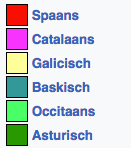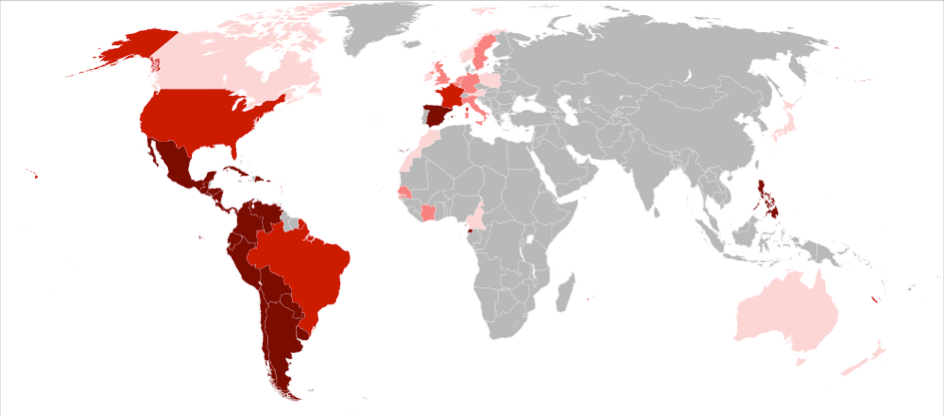Not all Spaniards speak Spanish: Languages in Spain
4 May 2018
Speaking of languages in Spain, we can get right to the point: not all Spaniards speak Spanish. In fact, in Spain they speak 1 official national language, 4 regional languages and several more unofficial ones! What we know as Spanish is actually "castellano" or "Castilian."
This map shows an overview of all the languages in Spain:


Castilian, the official national language of Spain
So what the rest of the world describes as Spanish is Castilian. It is the most widely spoken language in Spain and also one of the official languages of both the United Nations and the European Union. It is the only official national language of Spain and is spoken by 99% of Spaniards, as their mother tongue and second language.
Excerpt
They use the same alphabet as Dutch, plus a 27th letter: the ñ, pronounced like "nj" in orange. In addition, they pronounce some letters differently. The c and z are usually pronounced as s, except when followed by an -e, -o or -u, then it becomes a sharper sound like the English "th" in "think." Just think of Barcelona's Spanish pronunciation!
The B and V are pronounced the same in Spanish, like our Dutch B. The letter H is never pronounced. The R is always a rolling R. The W and K sound the same as in Dutch, but hardly occur in Spanish. The u sound is softer and, as in German, for example, is pronounced "oe."
In addition, there are the diphthongs. "ch" is considered one letter, pronounced "ch". So where we say Chile, that first sound in Spanish is preceded by a t: "tchile." The double "ll" sound is pronounced "lj". So the eternal debate about how to pronounce "paella" is hereby resolved, you say "paelja" as it were.
The regional languages of Spain
In addition to Castilian, there are 4 official regional languages in Spain. These are not dialects of Castilian, but languages in their own right. A number of smaller languages are also spoken, but they are not recognized as official languages of the country.
Catalan
Catalan is spoken by 7.5 million residents, about 18% of the total population. The language originated in Catalonia in the 8th century. Through territorial expansion, the language spread throughout the Mediterranean world. From the 15th century, the language declines again in favor of Castilian. In this video you will learn greetings and ways to say goodbye in Catalan.
https://www.youtube.com/watch?v=pwiSONoVUGA
Galician
Galician is the second largest regional language and has 2.5 million speakers (5.7% of the population). It is spoken in the northwestern part of the country and is therefore more similar to Portuguese than Spanish. This becomes clear, for example, when we conjugate the verb "to be" in both languages.
https://www.youtube.com/watch?v=Vp4yPUcqJaA
Basque
Basque is spoken by nearly 2.5% of the population, just over 1 million Spaniards. It is found in the region of the Pyrenees and has 5 dialects, 3 Spanish and 2 French. Basque is not a Romance language and therefore sounds very different. More than that, Basque has no linguistic link with any other European language. It is an isolated language, meaning that no genetic relationship can be demonstrated with other languages. Thus, unlike other European languages, Basque did not evolve from Indo-European. More on that:
https://www.youtube.com/watch?v=S1l9oDiSiEQ&t=0m43s
Occitan/Aranian
Aranese is the officially recognized regional language with the fewest speakers: only 4,000. It is a dialect of Occitan and thus has many French influences. The language is spoken in northwestern Catalonia, near the Spanish-French border. If you listen carefully, you will definitely hear the French influences:
https://www.youtube.com/watch?v=pdYpvY6Efos
History of Spanish
Spanish grew in the
5th century from various dialects of Folk Latin in Iberia. Folk Latin is the language the Romans spoke in everyday life. The different dialects developed further and further until they could be considered separate languages. The first written documents recovered using this early form of Spanish date from the 9th century.
Spanish then underwent influence from other neighboring Romance languages such as Catalan, Portuguese, Galician, Occitan, French and Italian. In the 13th century, Castilian was only really seen as a distinct language thanks to King Alfonso X. He decided to standardize the written language for official use, based on the dialect spoken in Toledo. This lasted until no less than the 16th century.
But in the meantime, the language continued to evolve. In the 1300s, the southern part of Spain known as Al-Andalus was under Muslim rule. During the Reconquista, this part was reconquered. Thus, Castilian also spread to the south and the language also underwent Arabic influences. Indeed, in Al-Andalus, Mozarabic dialects were spoken that contained very many Arabic loanwords. Nearly 4,000 loan words (8% of modern vocabulary) were thus adopted from Arabic.
From the 15th and 16th centuries, the language spread further to North and South America and the Spanish East Indies (now Southeast Asia), influenced by colonization. Since the standardization of the written language, begun by King Alfonso, had largely ended at that point, the written form of Spanish was largely the same everywhere. But of course the language continued to evolve in these new territories, resulting in major differences in pronunciation and local vocabulary.
Spanish as a world language
Spanish is thus a collective name for several dialects and languages that all developed and spread from Spain. It has more than 450 million native speakers. Consequently, it is the second most widely spoken native language in the world, after Chinese. Moreover, there are still 90 million people who speak it as a second language. Spanish is also one of the most widespread languages: there are at least 3 million native speakers in more than 44 countries, and it is an officially recognized language in 21 countries. It is also the third most widely used language online.


6 tips for learning Spanish
Spanish is a Romance language, so those who already speak other Romance languages (such as French, Italian or Romanian) already have an edge. To become fluent in the language, you will still need about three months. Of course, that depends on how intensively you learn the language, and how deeply you immerse yourself in it.
1. Take Spanish classes
This tip, of course, speaks for nothing. You cannot begin to learn a language without taking classes on it. Whether you attend an (evening) school, choose a language camp, or take online classes, it doesn't matter. You have to start somewhere!
2. Listen to Spanish music
Have you ever noticed picking up new words and phrases from your favorite music? It is an ideal way to become more familiar with a language. So listen to Spanish music and try to discover what it's about! Find the song lyrics and learn to sing along. A fun way to tutor.
3. Watch Spanish movies or television
Aside from music, watching television is also a playful way to learn a new language. Spain is known for its telenovelas. So if you want to catch up and enjoy overacting and almost implausible storylines at the same time, this is an ideal solution for you!
4. Spanish literature
Of course, we cannot talk about music and television without also mentioning literature. A tremendous amount is written in Spanish and there is also a whole series of classic works of literature, think of Don Quixote for example! Of course, this does not all have to be high literature. How about combining your love of cooking with learning a language? Spanish cookbooks abound!
5. Surround yourself with Spanish speakers
Of course, an important part of learning a language is also to speak it. Therefore, seek out Spanish-speaking people in your area, make new friends, find a pen pal or a slightly more modern Skype friend, for example, ... You still learn a language better by hearing it often and speaking it yourself. And that way, you also get to know Spanish culture right away. Win-win!
6. Learn on the go and everywhere
On the train, while walking your dog, in traffic jams, ... There are always times when it is possible to learn. In those moments, listen to Spanish music or podcasts, or try out one of the many apps. Our favorites:
- Duolingo is probably the most well-known app for learning a language. You start with simple words and grammar and can quietly build up. About 5 minutes a day is enough. The app is free with internet connection. Those who opt for a paid subscription can download lessons to learn offline and will no longer see ads.
- Babbel is another well-known app. The disadvantage here is that you learn a new language not from Dutch but from English. Here you learn mostly visually, coupled with pronunciation. In fact, you are presented with a new word with 3 possible images and you must then choose the correct one. The first lesson is free, then you pay between €5 and €10 per month depending on the length of your subscription.
- Google Translate, of course, should not be missing from your list for learning a language. If you are looking for a particular word, or don't understand a phrase, you can easily ask Google.
- SayHi can facilitate your conversations with non-native speakers. This app translates spoken text in two directions. First, the app recognizes what you say with speech recognition, and then it translates your text into the target language. You do need an active Internet connection for this.
- Spanish Podcast 101: If you like to learn with podcasts, Spanish 101 is the place to be. It's free and, above all, it teaches you how to speak well. With video and audio files, it is very easy to learn on the go. In addition, there is also an extensive forum where you can ask questions of fellow students.













